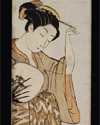 |
| The Demon-Queller Zhong Kui (Shoki or Sho Ki), about 1745, woodblock print, ink on paper (sumizuri-e) with hand-coloring; urushi-e; pillar print (hashira-e); John Chandler Bancroft Collection, 1901.1201 |
Through January 21, 2006
Hashira-e(-ban), a pillar-print format of narrow width, offered an exciting compositional challenge for 18th- and 19th-century woodblock-print masters. Pillar prints were designed by famous ukiyo-e artists, such as, Masanobu, Kiyomitsu, Harunobu, Koryusai, Choki and Utamaro. Motifs commonly depicted in pillar-print format are kabuki actors and courtesans, lovers, literary and legendary themes, parodies of classic subjects, beautiful women and handsome young men and auspicious New Year themes. Now rare collectibles, pillar-print images (hashira-e) were often mounted as hanging scrolls or pasted directly onto supporting house posts. The exhibition includes twenty-six pillar-prints (two mounted on scrolls) as well as a few woodblock printed books and subject-related objects.
This project is supported by The Heald Fund.
| Select Images from the Exhibition | ||

|

|
|
| (detail) | ||

|

|
|
| (detail) | ||

 Sign up for WAM eNews
Sign up for WAM eNews